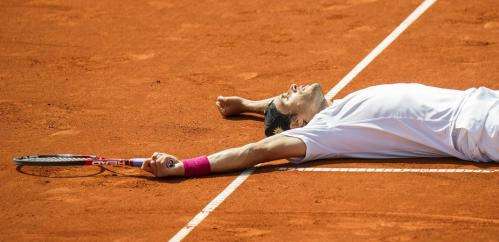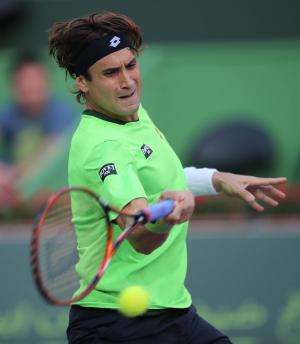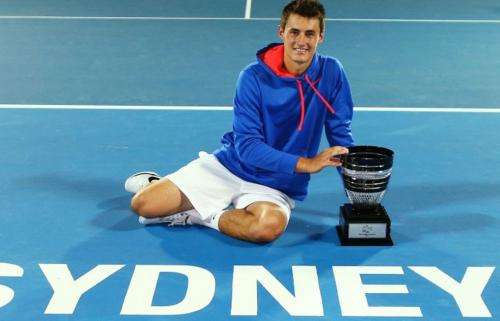Old is the new young, in tennis anyway: at 35 years old, Germany’s Tommy Haas is still winning tournaments. Credit: EPA/Marc Mueller
Lleyton Hewitt won the Brisbane International last weekend at the age of 32. Roger Federer and David Ferrer, two of the world's top ten players, are over 30. And 35-year-old crowd favourite Tommy Haas still maintains a world ranking of 12.
And as the world's top tennis players will again assemble on Monday to compete for the coveted Australian Open title, keen observers may notice a change. To put it bluntly, tennis players are getting older.
So why this apparent surge of older players? A study by The Institute of Sport, Exercise and Active Living (ISEAL), The Australian Institute of Sport (AIS) and Tennis Australia used 35 years of historical rankings data to uncover long-term trends in player development.
The study aimed to separate the fact from the fiction in the discussion of how tennis, and tennis players, are evolving – and you might be surprised by what we found.
A longer road to the top
On average, the age of a top-100-ranked athlete has indeed increased, at a rate of around one year per decade, over the past 35 years. This sounds like good news if you're a tennis player, but a closer look reveals otherwise.
Our results suggest the change is primarily the result of athletes taking longer to reach a top 100 ranking, rather than an increased total career length. Put simply, a tennis player's "window of opportunity" for achieving a top 100 ranking is narrowing, and it's the younger athletes who are being shut out.
Numbers published recently by the Association of Tennis Professionals (ATP) shows what effect this trend has had on the competition. In 2013, only four of the 64 top-tier tournaments were won by athletes under the age of 24. The average age of the current top 10 is 28 years.
Spain’s David Ferrer is 31 years old. Credit: EPA/Ali Haider
So what does this all mean for our Aussie young guns such as Nick Kyrgios and Thanasi Kokkinakis? Well, basically it means a longer road to the top compared to those that came before them. The days of the 17-year-old Wimbledon champion are behind us.
Shifting our expectations
The study informs the average fan as much as it does elite athletes. We often write off young athletes, whether it be in tennis or other sports. In Aussie tennis, no better example springs to mind than that of Bernard Tomic.
Tomic burst onto the tennis scene as an 18-year-old with quarter final appearance at the 2011 Wimbledon championships, and soon after achieved a ranking within the top 50. Unfortunately for Aussie fans, Bernard's ranking hasn't significantly progressed since.
Bernard Tomic with the winners trophy after the men’s singles final at the Sydney International tennis tournament in January 2013. Credit: AAP/Dean Lewins
Bernard cops plenty of criticism for his stagnant ranking, but is this always justified? Where should a 21-year-old be ranked in the modern game?
It may surprise you that Tomic is still the fifth youngest player in the top 200. As previously mentioned, young athletes are far less prevalent in modern tennis's elite group compared to yesteryear. There are only two players with a ranking in the top 100 under the age of 23 (Tomic and Czech Jiri Vesely).
So its hard to argue that Tomic's ranking should be better, given that he has already outperformed everybody in the world his age. Today more than ever patience is required, from athletes, commentators and fans alike.
Should tennis be concerned?
If you asked most people, they would likely say tennis players get a pretty fair deal. After all, athletes competing in this years Australian Open pocket A$27,600 if they lose first round!
But, the true story is far less glamorous once you factor in the costs. Tennis Australia estimates competing on tour costs about US$121,000-197,000 per year. A quick look at the ATP prize money winnings shows fewer than 200 players earned this amount in 2013.
The longer road to the "break even" ranking means it takes longer for athletes to become financially stable. Some tennis nations already have a problem with retaining young athletes, and the financial pressures faced by developing tennis players are partially to blame.
Its also harder for federations to identify the next top athlete, given the gap between junior and senior competition is widening. It's similar to how the seven-day weather forecast is less accurate than the four-day forecast – forecasting further into the future is harder to get right.
Mathematics plays a part here as well, with the development of Moneyball-type prediction algorithms at Tennis Australia.
So if you get the chance, get down to the Australian Open and cheer on a young gun – their road ahead is longer than ever before. And don't be surprised if an old head "who should have retired years ago" wins a few matches either.
Source: The Conversation
This story is published courtesy of The Conversation (under Creative Commons-Attribution/No derivatives).
![]()
























